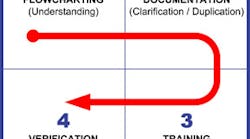Successful Project Management Implementation In Electrical Contracting Firms
As any experienced electrical contractor will tell you, implementing a company-wide project management (PM) system in a construction company has much more to do with training, change management, follow-up, and general “people processes” than it does with the capabilities, features, or technical innovation of the system. That's because certain problems inherent in implementing such a system always seem to crop up. Understanding what causes these problems is the key to making a smoother transition.
For starters, there is a minimal amount of standardization across the construction industry when it comes to project management tools. In fact, very few electrical contractors have a structured project management system in place. Even fewer have a training program for new hires or employees who are promoted from within. As a result, most project managers have a choice in how they execute the mechanics of their job. Combine this with the slew of excuses you're likely to hear from most project managers as to why they don't need a standardized project management system, and you'll quickly see why implementation of this type of program is doomed for failure. Fortunately, breaking down the transition process into smaller steps helps contractors make the move much more manageable.
Four phases to success
Effective implementation of a new system has four distinct phases (Fig. 1). Failure to follow this process will typically result in performance far below expectations.
Group meeting/flowcharting — Starting with a group of stakeholders in the project, it's important to get everyone's ideas out on the table in order to help bring everyone together in alignment. If outsiders are going to help with the implementation, this step will also assist their understanding of the company processes and dynamics of the group.
This phase is complete when everyone agrees to a basic flowchart of the process, time line, responsibilities for different parts of the endeavor, and a simple bullet-point description of the process.
Process documentation — This step encompasses the tedious process of filling in all of the details for a particular process, such as processing a request for information (RFI). For example, you should document how to write the RFI, when it should be written, tactics for successful wording of the RFI, linking the RFI to changes, specific format and templates for attached sketches, and how to name any file attachments sent with RFIs.
This documentation should come in several formats, depending on exactly what the process is, including a written process that can go in a binder, online video, and possibly a slide presentation for training in larger groups. Having your company documented at this level of detail will improve current performance and make hiring and training new team members much easier, significantly increasing the value of any company.
Training — If you've properly documented your processes, a good portion of the team likely will have already begun using the new process. Training will be more about hands-on resolution of problems and documenting details about how to perform a task better.
For example, knowing how to fill out an RFI in any system is easy. When, why, and how to write an effective RFI that improves customer relationships, boosts field productivity, and secures both change order revenue and additional contract days are areas in which you should focus your training efforts.
Verification — Even if you execute the first three phases perfectly, certain people will still not follow the new system — either intentionally or unintentionally. The biggest value a project management system based on a central database has over individual spreadsheet applications is the ability to run cross-company reports and see who is and isn't doing their job.
That's why it's important to address some quality control methods when the process is being designed. This often requires you to build simple queries into the system database. These queries are all relatively simple, with most software providers having solid capabilities for using third-party reporting tools or linking into the data with Excel.
A simple example of this is shown in (click here to see Fig. 2). This report verifies if people are filling out daily logs and holding weekly production/safety meetings. The screen shot report is simple enough to read. Red equals bad. So fix it! Reports like this should be built for all critical processes. For some, it only takes a few weeks of monitoring before everyone gets into a habit, and then the verification process can be used only for spot checking.
A realistic time line for adoption of a standardized PM system is one year. This is based on a successful approach that focuses on building a strong foundation before moving to the next level. However, the time line will vary depending on the complexity of the system being implemented, the company's size, geographic location(s), and how receptive the overall team is to change.
Practical pointers
When looking at the big picture, several objectives must be met. First of all, setup is critical. It's also important not to underestimate the details. The more attention you pay to every detail involved in setting up the project management system, the faster the rollout process will be. Pay special attention to the following items:
Standardized forms/reports — This may seem like a minor detail, but it is actually a very big selling point for project managers. Every customer form should have the exact same look and feel.
Company-wide setup — Some of the settings in the project management system will be company-wide. These should be established before anyone starts using the system, including submittal status, change request status, standard messages, custom issue categories, RFI categories, and document types. Once they're set up, no one should change or modify them.
Project setup — With the company setup out of the way, focus on making sure basic elements are established for each project, including project directory, specification sections, e-mail contacts, and project specific forms.
Basic training/documentation — When training a large number of people on how to use a standardized system, it should be clearly documented.
One of the biggest mistake contractors make when implementing any standardized system is the lack of setup time. Unfortunately, many implementations are given little preplanning effort, which leads to subpar results.
Brown is the founder/president of D. Brown Management, a consulting firm located in Lodi, Calif. He can be reached at [email protected].
Processes vs. Software
Successful project management is mainly about being a good leader — and staying on top of the hundreds of balls that are in the air at any given time. This means software is not the magic solution.
The fact is, software has very little to do with the success of a standardized project management system. The challenge is in clearly understanding what the company processes are that lead to a successful project, and then seeing how software can streamline those processes.
Sidebar: Ducks in a Row
Before you dive into a new project management system, it's important to take that critical first step. Outline all of the things you do as a company to manage projects. Make a list similar to the Table below with responsibilities (click here to see Table), and then start working on standardizing and streamlining them, giving priorities based on return on investment (ROI).



